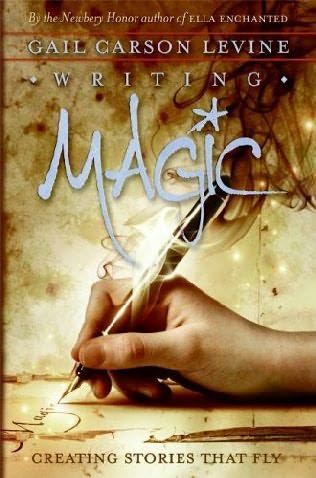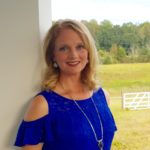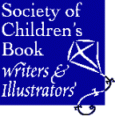
It’s no easy task, getting most kids to write a paragraph, much less a full creative story. That’s why I felt like I’d uncovered a treasure, when I happened upon Gail Carson Levine’s Writing Magic: Creating Stories That Fly. It was parked on the same shelf near a biography of J.K. Rowling that I was checking out for my kids.
We’ve long been fans of Gail Carson Levine’s Newbery Honor work, Ella Enchanted, one of the rare children’s books that survived being transformed into a movie. In fact, it was the movie, starring Anne Hathaway, that got me reading the novel, along with my daughters. Amazing! Levine’s writing is magical, and she doesn’t keep her methods secret. She willingly shares writing tips in classes she teaches to children and adults, as well as on her blog.
If you have a budding young writer in your family (or if YOU are longing to create fiction), Writing Magic is sure to inspire. It’s filled with writing advice, story starters, and most of all, encouragement. Levine believes writing should be fun, and if it’s not, then something is wrong!
In the first chapter, Levine lists her seven rules for writing:
1. The best way to write better is to write more.
2. The best way to write better is to write more.
3. The best way to write better is to write more.
4. The best way to write more is to write whenever you have five minutes and wherever your find a chair and a pen and paper or your computer.
5. Read! Most likely you don’t need this rule. If you enjoy writing, you probably enjoy reading. The payoff for this pleasure is that reading books shows you how to write them.
6. Reread! There’s nothing wrong with reading a book you love over and over. When you do, the words get inside you, become part of you, in a way that words in a book you’ve read only once can’t.
7. Save everything you write, even if you don’t like it, even it you hate it. Save it for a minimum of fifteen years. I’m serious …
Levine goes on to explain that last rule. She said she used to think she’d always remember what it felt like to be a kid, but she discovered (as we all do) that you forget the details. The only way to absolutely remember how you feel being a child is to write as a child, and then save those writings.
She further explains:
When you become a teenager, you step onto a bridge. You may already be on it. The opposite shore is adulthood. Childhood lies behind. The bridge is made of wood. As you cross, it burns behind you.
If you save what you write, you still won’t be able to cross back to childhood. But you’ll be able to see yourself in that lost country. You’ll be able to wave to yourself across that wide river.
As a mother, I’m always trying to get my children to write in journals. It’s worked for some of my kids, who love to record their memories, but not for others, who would rather be doing ANYthing but writing. Seeing Levine explain it all so clearly reminded me that someday, if their journals survive the years, they’ll appreciate being able to “wave” to themselves across the bridge from adulthood back to their childhoods.
I haven’t always been good at keeping a journal, though it’s a practice I’ve become passionate about the last fifteen years or so. For me, it’s a connection to my spiritual life, to God, because when I put ink to paper I can block out the distractions of the world (most of the time) and enter into my Quiet Place, where I find the strength and joy I need to face my day. I think kids also benefit greatly from being able to sort out their ups and downs in written form. Diaries are also fascinating raw material for creating fiction.
In Writing Magic, Levine explains why she writes fiction, which I enjoyed reading about. She writes for several reasons: to enjoy the power of creation, to tell a good story, and to make discoveries — about herself and others. As parents, if we can pass along this desire to create through words, we’ll be enabling our children to make their own discoveries. What a noble calling!
Throughout this book, Levine uses examples from her own novels as well as other famous children’s works, to clarify her points. I loved being able to enter into her thought process, as to how she came up with her ideas for books such as Ella Enchanted, Fairest, The Wish, and others. She also offers advice on how to come up with interesting characters and plots that will hook readers, as well as how to inject humor into your writing. Finally, she shares her own publishing journey, and encourages her readers to persevere in getting their work out there.
Levine closes every chapter with two simple commands: “Have fun!” and “Save what you wrote.” She also ends her posts the same way in her blog for young writers. It can’t get much simpler than that.
I hope you get a chance to pick up a copy of Writing Magic. Here’s what the author says on her website about her own book:
When I wrote Writing Magic I’d been teaching creative writing to wonderful middle school kids for six years.
I love to talk, teach, and write about writing. I made up prompts, and we tried them together. If a prompt worked for me, it worked for them, and vice versa. I invented a few prompts just for the book, but almost all are workshop tested, just as you’d expect recipes in a kitchen to have been cooked at least once. I love dreaming up prompts, and they’re probably my favorite parts of the book. Writing Magic is my only banned book, as far as I know. It was banned from middle schools in a district in Illinois because I advise readers to make their characters suffer. In my opinion, a how-to about writing that advised against making characters suffer—that would be the book to ban!
Ha! See? You’ll love this book.
You can read more about Gail Carson Levine on her website or blog.






One Response to Book Review: Writing Magic, by Gail Carson Levine